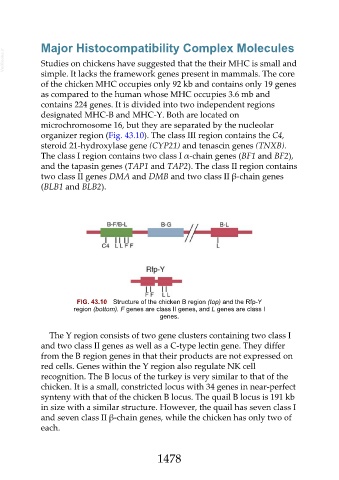Page 1478 - Veterinary Immunology, 10th Edition
P. 1478
Major Histocompatibility Complex Molecules
VetBooks.ir Studies on chickens have suggested that the their MHC is small and
simple. It lacks the framework genes present in mammals. The core
of the chicken MHC occupies only 92 kb and contains only 19 genes
as compared to the human whose MHC occupies 3.6 mb and
contains 224 genes. It is divided into two independent regions
designated MHC-B and MHC-Y. Both are located on
microchromosome 16, but they are separated by the nucleolar
organizer region (Fig. 43.10). The class III region contains the C4,
steroid 21-hydroxylase gene (CYP21) and tenascin genes (TNXB).
The class I region contains two class I α-chain genes (BF1 and BF2),
and the tapasin genes (TAP1 and TAP2). The class II region contains
two class II genes DMA and DMB and two class II β-chain genes
(BLB1 and BLB2).
FIG. 43.10 Structure of the chicken B region (top) and the Rfp-Y
region (bottom). F genes are class II genes, and L genes are class I
genes.
The Y region consists of two gene clusters containing two class I
and two class II genes as well as a C-type lectin gene. They differ
from the B region genes in that their products are not expressed on
red cells. Genes within the Y region also regulate NK cell
recognition. The B locus of the turkey is very similar to that of the
chicken. It is a small, constricted locus with 34 genes in near-perfect
synteny with that of the chicken B locus. The quail B locus is 191 kb
in size with a similar structure. However, the quail has seven class I
and seven class II β-chain genes, while the chicken has only two of
each.
1478

